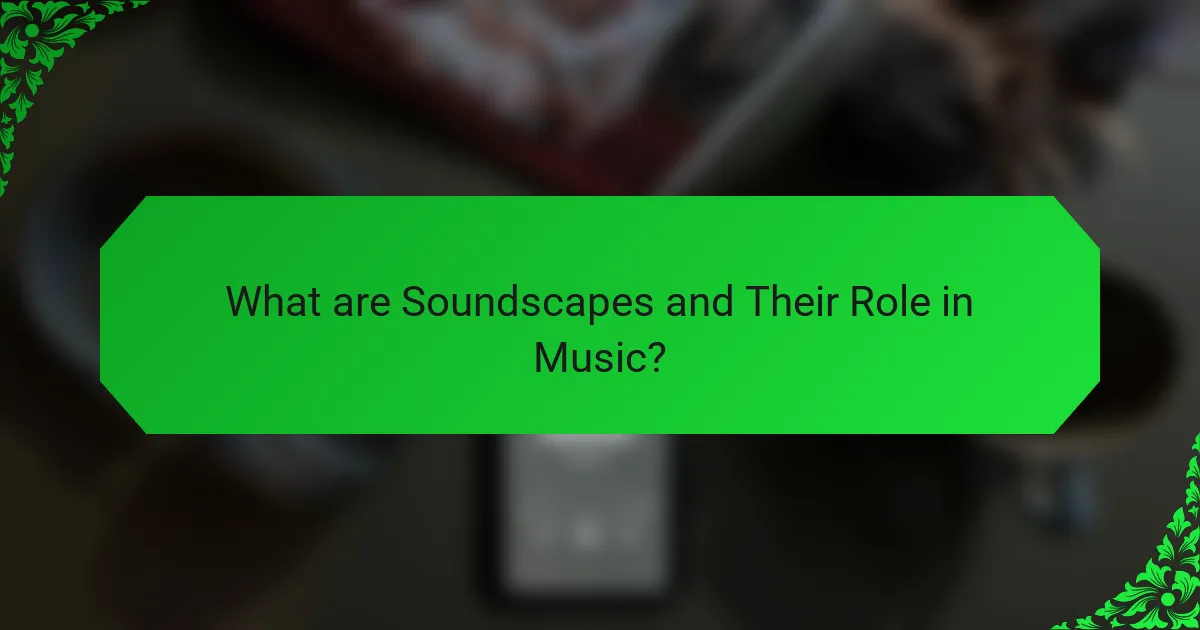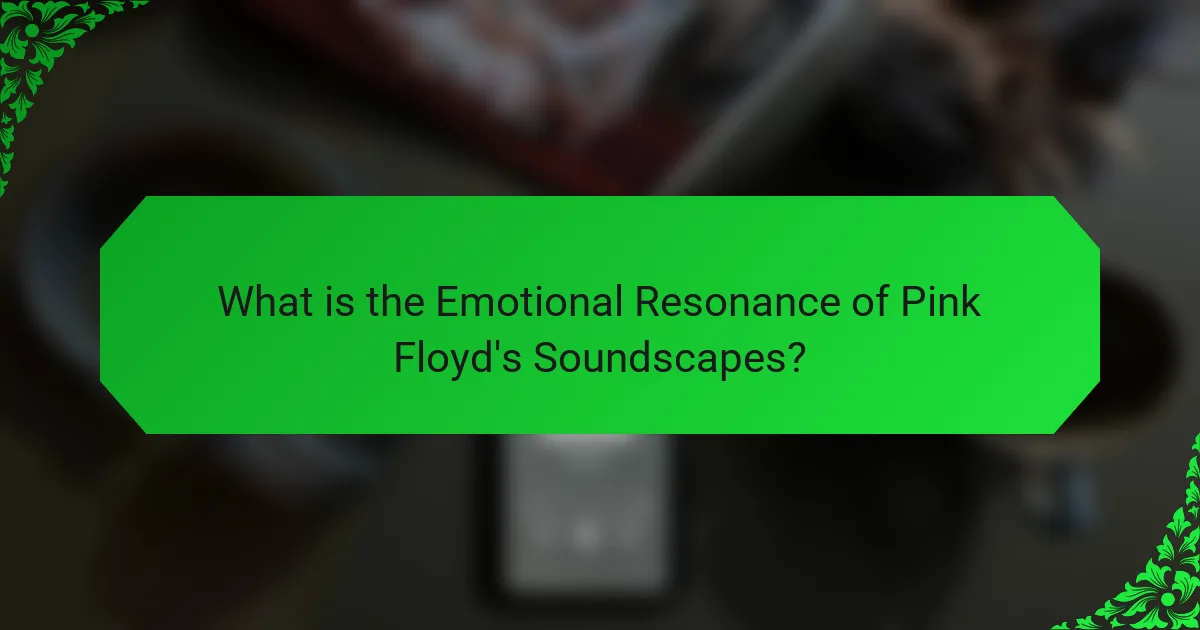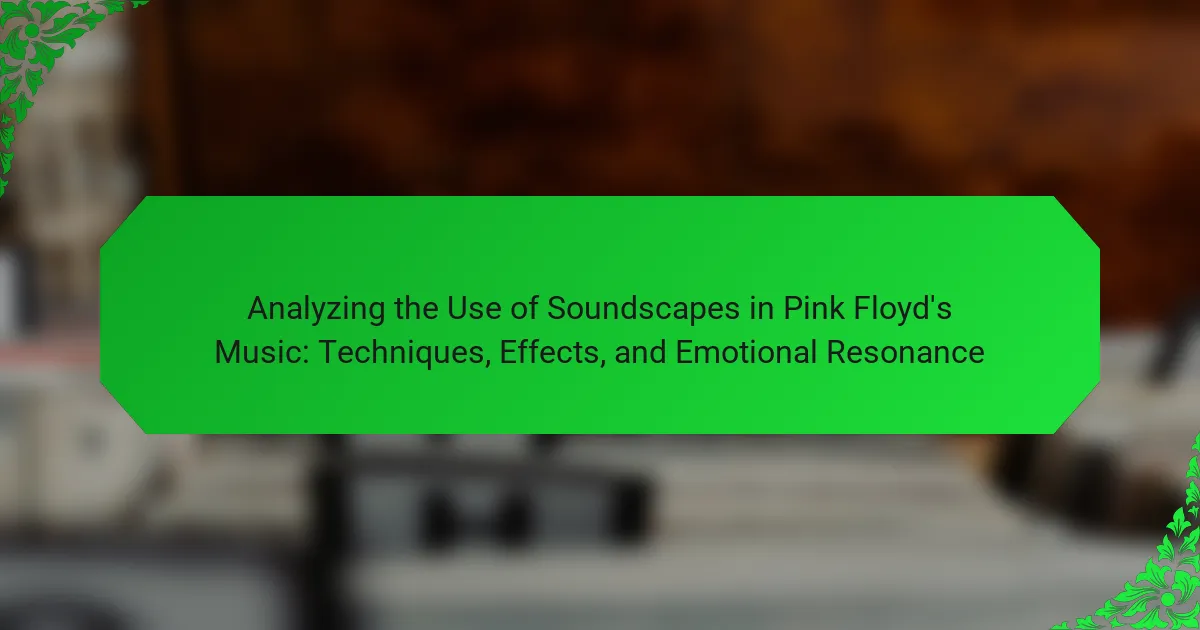Soundscapes are aural environments created by blending various sounds, including natural sounds, ambient noise, and musical elements. This article analyzes the use of soundscapes in Pink Floyd’s music, highlighting the techniques the band employs, such as synthesizers, sound effects, and multi-layered instrumentation, to create immersive auditory experiences. It explores how these soundscapes enhance emotional resonance, engaging listeners and deepening their connection to the music. The discussion also includes the psychological effects of soundscapes on emotions and cognitive performance, illustrating their significance in shaping listener experiences.

What are Soundscapes and Their Role in Music?
Soundscapes are aural environments created by combining various sounds. They can include natural sounds, ambient noise, and musical elements. In music, soundscapes enhance the emotional and atmospheric qualities of a piece. They provide context and depth, allowing listeners to immerse themselves in the experience. For example, Pink Floyd often used soundscapes to evoke specific feelings. Their album “The Dark Side of the Moon” features soundscapes that reflect themes of time and mental health. This technique engages listeners and deepens their connection to the music. Soundscapes are essential for creating a rich auditory experience.
How do soundscapes enhance the listening experience?
Soundscapes enhance the listening experience by creating immersive auditory environments. They add depth and texture to music, making it more engaging. Soundscapes can evoke emotions and memories, enriching the listener’s connection to the content. In Pink Floyd’s music, soundscapes serve to transport listeners to different realms. For example, the use of ambient sounds in “The Dark Side of the Moon” contributes to its thematic complexity. Studies show that soundscapes can improve focus and retention of information. This underscores their role in enhancing overall enjoyment and understanding of music.
What elements constitute a soundscape in music?
A soundscape in music consists of various elements that create an auditory environment. These elements include natural sounds, instrumental layers, and electronic effects. Natural sounds can be field recordings or ambient noises that provide context. Instrumental layers involve melodies, harmonies, and rhythms that form the musical structure. Electronic effects enhance the soundscape by adding texture and depth. Together, these components contribute to the overall atmosphere of a piece. Soundscapes can evoke emotions and transport listeners to different settings. For instance, Pink Floyd often used soundscapes to convey themes and enhance storytelling in their music.
How do soundscapes differ from traditional musical composition?
Soundscapes differ from traditional musical composition primarily in their focus on environmental sounds rather than structured melodies. Traditional music typically emphasizes rhythm, harmony, and melody, creating a defined musical form. In contrast, soundscapes prioritize ambient noise and textures, often incorporating non-musical elements.
Soundscapes are designed to evoke specific atmospheres or emotions through the use of natural sounds and recordings. For example, Pink Floyd’s use of soundscapes often blends musical elements with field recordings to create immersive experiences. This method allows for a more fluid interpretation of sound, breaking away from conventional music structures.
Research shows that soundscapes can enhance emotional responses by engaging listeners in a more organic way. For instance, studies indicate that natural sounds can reduce stress and promote relaxation, which is a key aspect of soundscape composition.
Why is Pink Floyd Notable for Their Use of Soundscapes?
Pink Floyd is notable for their use of soundscapes due to their innovative integration of ambient sounds and effects. They pioneered techniques that transformed traditional music into immersive auditory experiences. Their albums, particularly “The Dark Side of the Moon” and “Wish You Were Here,” feature extensive use of studio effects, tape loops, and synthesizers. This approach creates a rich atmosphere that enhances emotional depth. The use of soundscapes allows listeners to engage with the music on multiple levels. Pink Floyd’s soundscapes often evoke feelings of nostalgia, isolation, and existential reflection. Their experimentation with sound has influenced countless artists across genres. This legacy solidifies their position as pioneers in the realm of sound design in music.
What unique attributes define Pink Floyd’s soundscapes?
Pink Floyd’s soundscapes are defined by their innovative use of ambient textures and conceptual themes. The band incorporates long instrumental passages that evoke deep emotional responses. They utilize sound effects and synthesizers to create immersive auditory experiences. Their music often features complex arrangements and unconventional song structures. The lyrical content is introspective and philosophical, enhancing the overall atmosphere. Live performances include elaborate visual elements that complement the soundscapes. The band’s use of dynamics contrasts quiet, reflective moments with powerful crescendos. These attributes contribute to the unique identity of Pink Floyd’s musical legacy.
How has Pink Floyd’s approach to soundscapes influenced other artists?
Pink Floyd’s approach to soundscapes has significantly influenced numerous artists across various genres. Their use of innovative studio techniques and atmospheric sounds set a new standard for album production. Artists like Radiohead and Porcupine Tree have cited Pink Floyd as a major inspiration in creating immersive auditory experiences. The band’s incorporation of non-musical elements, such as spoken word and environmental sounds, has encouraged others to explore similar methods. This experimentation has led to the development of post-rock and ambient music genres. Furthermore, their thematic focus on existential concepts has resonated with contemporary musicians, prompting deeper lyrical exploration. The sonic layering and dynamic shifts in their compositions have also shaped the work of modern progressive rock bands. Overall, Pink Floyd’s pioneering soundscapes continue to inspire a diverse range of artists today.

What Techniques Does Pink Floyd Use in Their Soundscapes?
Pink Floyd employs various techniques in their soundscapes to create immersive audio experiences. They utilize synthesizers to generate unique sounds and textures. The band often incorporates sound effects and field recordings, enhancing the atmosphere of their music. They also use multi-layered instrumentation, allowing for complex arrangements. Dynamic contrasts are applied, creating tension and release throughout their tracks. Additionally, vocal effects, such as echo and reverb, contribute to the ethereal quality of their sound. Their use of thematic motifs ties songs together, reinforcing emotional resonance. These techniques collectively contribute to the distinctive and innovative sound of Pink Floyd.
How does layering contribute to Pink Floyd’s soundscapes?
Layering significantly enhances Pink Floyd’s soundscapes by creating depth and complexity. The band employs multiple instrumental and vocal tracks simultaneously. This technique allows for a rich auditory experience. Each layer adds unique textures to the overall sound. For example, synthesizers, guitars, and vocals often intertwine. This results in immersive sound environments. The use of layering also supports thematic elements in their music. Tracks like “Echoes” exemplify this approach with intricate sound combinations.
What specific instruments are commonly used in their soundscapes?
Pink Floyd commonly uses synthesizers, guitars, and drums in their soundscapes. The Moog synthesizer is a signature instrument, providing rich, electronic textures. Guitars, particularly David Gilmour’s, deliver iconic solos and atmospheric chords. Drums, played by Nick Mason, establish rhythmic foundations. Additionally, the band incorporates sound effects and tape loops to enhance the auditory experience. These elements combine to create immersive soundscapes that evoke deep emotional responses. The use of these instruments is evident in albums like “The Dark Side of the Moon” and “Wish You Were Here.”
How do effects and production techniques shape their soundscapes?
Effects and production techniques significantly shape soundscapes by manipulating audio elements. Techniques such as reverb create a sense of space and depth. Delay effects add echoes, enriching the auditory experience. Equalization adjusts frequency ranges, enhancing clarity or warmth. Panning distributes sound across the stereo field, creating movement. Layering multiple tracks produces a fuller sound. Compression controls dynamics, ensuring consistency in volume levels. These methods contribute to the overall emotional impact of the music. Pink Floyd’s use of these techniques is evident in tracks like “Echoes,” where soundscapes evoke feelings of isolation and introspection.
What role does improvisation play in Pink Floyd’s soundscapes?
Improvisation plays a crucial role in Pink Floyd’s soundscapes. It allows the band to explore spontaneous musical ideas. This technique enhances the emotional depth of their compositions. Live performances often featured extended improvisational sections. These segments contributed to unique interpretations of their studio recordings. The use of improvisation creates an unpredictable element in their music. It engages listeners by providing fresh experiences at each performance. Notable examples include the improvisational solos in “The Great Gig in the Sky” and “Echoes.” These moments showcase the band’s synergy and creativity in real-time.
How do live performances differ from studio recordings in soundscapes?
Live performances differ from studio recordings in soundscapes primarily in their spontaneity and audience interaction. In live settings, musicians often adapt their soundscapes in real-time, responding to the energy of the audience. This creates a dynamic and evolving auditory experience. Studio recordings, however, are meticulously crafted and edited, resulting in a polished and controlled sound. The layering of instruments and effects in studios allows for intricate sound design that may not be replicable live. Additionally, live performances can incorporate ambient sounds from the venue, adding an organic element to the soundscape. In contrast, studio recordings utilize sound engineering techniques that can enhance clarity and balance. Research indicates that live performances evoke stronger emotional responses due to their immersive nature, as shown in studies on audience engagement and music perception.
What improvisational techniques are frequently employed by the band?
Pink Floyd frequently employs techniques such as modal interchange and call-and-response in their improvisational performances. Modal interchange allows musicians to shift between different scales, creating a varied emotional landscape. Call-and-response techniques involve one musician playing a phrase, followed by a response from another, fostering interaction and spontaneity. These techniques are evident in live performances, where improvisation enhances the overall soundscape. The band’s use of these methods contributes to their unique sound and emotional depth.

What Effects Do Soundscapes Have on Listeners?
Soundscapes significantly influence listeners’ emotions and perceptions. They can evoke feelings of calmness, nostalgia, or tension. Studies show that soundscapes enhance cognitive performance and creativity. For example, natural soundscapes improve focus and reduce stress. Research by Brambilla et al. (2019) highlights how specific sound elements impact mood. Soundscapes also create immersive experiences, enhancing engagement with music. This engagement can lead to deeper emotional connections with the content. Overall, soundscapes play a crucial role in shaping listener experiences.
How do soundscapes evoke emotional responses in listeners?
Soundscapes evoke emotional responses in listeners through the use of auditory elements that create immersive environments. These elements include natural sounds, musical textures, and ambient noise. Each sound can trigger specific emotions based on cultural associations and personal experiences. Research shows that soundscapes can influence mood and feelings of nostalgia. For instance, a study by Brattico et al. (2013) found that complex soundscapes elicit stronger emotional reactions compared to simple ones. The layering of sounds in Pink Floyd’s music exemplifies this technique, enhancing the emotional depth of their compositions.
What psychological effects are associated with Pink Floyd’s soundscapes?
Pink Floyd’s soundscapes evoke a range of psychological effects. Their use of ambient sounds creates a sense of immersion. This immersion can lead to altered states of consciousness. The music often triggers emotional responses such as nostalgia and introspection. Studies show that soundscapes can enhance mood and reduce anxiety. For example, the track “Echoes” uses layered instrumentation to create a tranquil atmosphere. This atmosphere fosters relaxation and contemplation. Additionally, their themes often explore existential topics, prompting deep reflection in listeners.
How do soundscapes influence the overall narrative of their music?
Soundscapes significantly influence the overall narrative of music by creating immersive environments. They enhance emotional depth and set the mood for the listener. In Pink Floyd’s music, soundscapes are used to convey themes and concepts. For example, the use of ambient sounds in “The Dark Side of the Moon” establishes a sense of introspection. This technique allows listeners to connect more deeply with the lyrics and musical progression. The layering of sounds can evoke specific imagery or feelings. Research shows that soundscapes can trigger emotional responses, influencing how narratives are perceived. Thus, soundscapes serve as a crucial element in shaping the storytelling aspect of music.
In what ways do soundscapes contribute to thematic elements in Pink Floyd’s albums?
Soundscapes in Pink Floyd’s albums enhance thematic elements through immersive auditory experiences. They create atmospheric settings that reflect the emotional landscape of the lyrics. For example, the soundscapes in “The Dark Side of the Moon” evoke feelings of anxiety and existential contemplation. The use of environmental sounds, such as clocks and voices, reinforces themes of time and madness. Additionally, sound layering adds depth to the narrative, allowing listeners to engage more fully with the music’s message. Tracks like “Echoes” showcase how extended instrumental sections can convey a sense of journey and exploration. Overall, soundscapes serve as a crucial tool for expressing complex themes in Pink Floyd’s work.
What are some examples of albums where soundscapes play a critical role?
“Dark Side of the Moon” by Pink Floyd exemplifies the critical role of soundscapes. The album features rich auditory textures that enhance its themes. “Wish You Were Here” also employs soundscapes to evoke emotion. The opening track uses ambient sounds to create a sense of space. “Animals” showcases environmental sounds that reflect its lyrical content. “The Wall” integrates soundscapes to depict psychological states. Each of these albums demonstrates how soundscapes contribute to the overall listening experience.
How do soundscapes enhance storytelling in specific songs?
Soundscapes enhance storytelling in specific songs by creating immersive auditory environments. These soundscapes support narrative themes and emotions. For instance, Pink Floyd’s “The Dark Side of the Moon” uses sound effects to convey mental struggles. The ticking clocks in “Time” symbolize the passage of time and urgency. Ambient noises in “Speak to Me” set a reflective mood, drawing listeners into the narrative. Soundscapes can evoke specific feelings, enhancing the listener’s connection to the story. Research indicates that soundscapes can significantly influence emotional responses in music, making the storytelling more impactful.

What is the Emotional Resonance of Pink Floyd’s Soundscapes?
The emotional resonance of Pink Floyd’s soundscapes is profound and multifaceted. Their music evokes deep feelings through innovative use of instrumentation and production techniques. The band employs ambient sounds, synthesizers, and effects to create immersive auditory experiences. Tracks like “Wish You Were Here” and “Comfortably Numb” showcase this emotional depth. The lyrics often explore themes of isolation, existentialism, and nostalgia, enhancing the listener’s emotional connection. Research indicates that music can significantly influence emotions, and Pink Floyd’s compositions exemplify this phenomenon. Their soundscapes resonate with listeners on a personal level, creating a lasting impact.
How do soundscapes create a sense of atmosphere in Pink Floyd’s music?
Soundscapes in Pink Floyd’s music create a sense of atmosphere through layered instrumentation and effects. The band utilizes ambient sounds, synthesizers, and field recordings. These elements immerse listeners in a sonic environment. For example, tracks like “Echoes” feature natural sounds that evoke a sense of space. The use of reverb and delay enhances the depth of the music. This creates an emotional resonance that complements the lyrical themes. The atmospheric quality of their soundscapes is a defining characteristic of Pink Floyd’s style. Their innovative techniques have influenced many genres, establishing a unique auditory experience.
What techniques are used to convey specific emotions through soundscapes?
Techniques used to convey specific emotions through soundscapes include layering sounds, utilizing silence, and manipulating dynamics. Layering sounds creates depth and complexity, evoking feelings of nostalgia or tension. Silence can emphasize emotional moments, allowing listeners to reflect. Manipulating dynamics, such as varying volume and intensity, enhances emotional impact. For example, crescendos can build excitement, while decrescendos may evoke sadness. Additionally, the use of specific instruments can also influence emotions; for instance, strings often convey warmth, while dissonant chords can create unease. These techniques are prevalent in Pink Floyd’s music, effectively enhancing emotional resonance within their soundscapes.
How do listeners interpret the emotional messages in their soundscapes?
Listeners interpret emotional messages in their soundscapes through personal associations and contextual cues. They often rely on musical elements like melody, harmony, and rhythm to gauge emotions. Soundscapes can evoke feelings by mimicking real-world sounds or creating immersive environments. Research indicates that familiar sounds trigger specific emotional responses based on individual experiences. For example, a gentle breeze may evoke calmness, while thunder can instill fear. The emotional impact is also influenced by the listener’s mood and cultural background. Studies show that soundscapes can enhance narrative elements in music, deepening emotional engagement. Thus, listeners actively decode these messages using cognitive and emotional frameworks.
What are the key takeaways for appreciating soundscapes in Pink Floyd’s music?
Key takeaways for appreciating soundscapes in Pink Floyd’s music include understanding their innovative use of studio technology. Pink Floyd employed multi-layered sound effects to create immersive experiences. They often integrated natural sounds and dialogue to enhance emotional depth. The band used unconventional song structures to emphasize their soundscapes. Their albums, such as “The Dark Side of the Moon,” showcase seamless transitions between tracks. These transitions contribute to a cohesive auditory journey. Listening to the dynamics in their music reveals shifts in mood and intensity. Recognizing these elements enhances the overall appreciation of their artistry.
How can listeners deepen their understanding of soundscapes in music?
Listeners can deepen their understanding of soundscapes in music by actively engaging with the auditory elements present in compositions. This involves focusing on the layers of sound, including instruments, vocals, and effects. Analyzing how these elements interact creates a richer listening experience.
Listeners should explore the context of the music, including the historical and cultural background. Understanding the artist’s intentions can enhance appreciation. For instance, Pink Floyd often used soundscapes to evoke emotions and convey themes.
Listening to various interpretations of the same piece can also provide insights into different soundscape elements. Engaging in discussions or reading analyses can further enrich comprehension. This multifaceted approach allows listeners to appreciate the complexity and artistry of soundscapes in music.
What practical tips can enhance the experience of listening to Pink Floyd’s soundscapes?
To enhance the experience of listening to Pink Floyd’s soundscapes, use high-quality headphones or speakers. High-fidelity audio equipment can reproduce the intricate details in their music. Listen in a quiet environment to minimize distractions. This allows for deeper immersion in the soundscapes.
Consider the album’s context and themes. Understanding the narrative behind albums like “The Dark Side of the Moon” enriches the listening experience. Engage with the music visually by watching live performances or visual interpretations. This can deepen emotional connections to the soundscapes.
Explore the lyrics and their meanings. Pink Floyd’s lyrics often complement their soundscapes, adding layers to the experience. Finally, allow yourself to listen without interruption. Extended, uninterrupted listening sessions can lead to greater appreciation of the atmospheric elements in their music.
The main entity of this article is soundscapes in the music of Pink Floyd. The article analyzes the techniques employed by the band to create immersive auditory experiences, detailing how soundscapes enhance emotional resonance and narrative depth. It explores the specific elements that constitute soundscapes, their differences from traditional musical composition, and the psychological effects on listeners. Additionally, it highlights Pink Floyd’s innovative approach and its influence on other artists, while providing practical tips for appreciating their soundscapes. Overall, the article offers a comprehensive examination of the role soundscapes play in Pink Floyd’s music and their impact on the listening experience.
